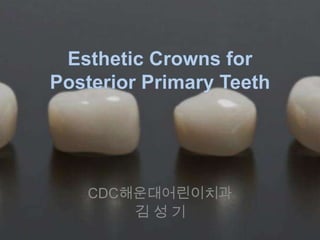
Esthetic crowns for posterior primary teeth
- 5. ZIRCONI A
- 7. WHAT IS ZIRCONIA? • Physical property : close to metal • Color : tooth-like • “Ceramic Steel”
- 8. 압축강도(Mpa) 인장강도(Mpa) Composite resin 70~80 30~50 Amalgam 300~500 45~60 GI 93~226 - Porcelain 150~600 30~60 ZPC 100~160 3~8 ZOE 2~14 - Ni-Cr - 400~1000 Enamel 270~400 - Dentin 230~300 40~50 ZIRCONIA 2000 900~1200
- 9. Scanning electron microscopy(SEM) observation of fibroblasts cultured on zirconia : cells grow on the whole zirconia surface, covering it with a cellular layer.
- 10. Kinder Krown (pre-veneered) NuSmile ZR Dr. Jorge Casian Adem(Mexico)
- 12. 6 weeks later Notice : plaque accumulation on SSC and healthy gingiva on NuSmile ZR(canine)
- 13. 마모
- 14. Dental wear is defined as tooth loss or surface damage caused by direct contact between teeth or between teeth and other materials. Dental wear, one of the physiological phenomena that are experienced in a lifetime, occurs as a complex form of chemical and mechanical wear. The surface hardness and friction coefficient are commonly used to estimate the degree of wear of restorative dental materials. Conventionally, greater hardness has been believed to cause more wear. Therefore, more wear was expected from zirconia, as zirconia has strong surface hardness. According to scientific studies, however, there is no significant correlation between the restoration hardness and the degree of wear of antagonistic teeth. On the other hand, the degree of wear is more affected by the surface structure and the roughness of the restorations or environmental factors.
- 16. Wear of Pediatric Enamel by Different Ceramic Materials Gary Frey, DDS Davette Johnson, DDS Houston Center for Biomaterials and Biomimetics University of Texas School of Dentistry at Houston 7500 Cambridge St. Suite 5350 Houston, TX 77054-2008 Stylus Material X-axis wear Y-axis wear Depth 1 Zirconia 93.6 microns 98.8 microns 46 microns 3 Zirconia 118.2 microns 110.6 microns 112 microns 5 Zirconia 93.2 microns 75.1 microns 75 microns 7 Zirconia 94.8 microns 85.3 microns 41 microns 2 Alumina 100.2 microns 95.3 microns 42 microns 4 Alumina 101.6 microns 88.3 microns 57 microns 6 Alumina 94.3 microns 105.0 microns 54 microns 8 Alumina 87.3 microns 95.3 microns 66 microns height width Using a Leinfelder style in-vitro wear-test apparatus, 800,000 cycles
- 17. Zirconia Stylus Tips Wear screening performed with LEINFELDER testing instrument What about wear to opposing primary teeth? Frey et al., Houston Center for Biomaterials and Biomimetics (2012)
- 19. Preparation
- 20. Use a football or coarse tapered diamond to reduce the occlusal surface of the tooth 1-2mm following occlusal contours. Tooth Preparation
- 21. Carefully prep tooth supragingivally to avoid tissue masceration. Reduce the tooth 20% overall or 0.5- 1.25 mm on all planes of the tooth. Black stripe – 5855
- 22. Use a fine thin tapered diamond - create a feather-edge margin 1-2mm subgingivally Green Stripe - 6852 Make sure no subgingival shoulders or ledges remain
- 23. Round line angles. Overall tooth reduction = approximately 20%
- 29. cementation
- 30. Ready-made crown Bonding or luting? Gap-filling!
- 34. Bonding agent + ceramic primer Self-etching primer to dentin One component One component Classification of Resin Cement
- 36. Bonding Mechanisms of Zirconia- based Ceramics
- 37. O OH OH P R Zr Zr O OOO Zr Zr O OO OO O P R Bonding mechanism of MDP to Zirconia
- 38. 38 Bonding mechanism of Phosphoric ester monomer to zirconia Zr4+ Zr4+ Zr4+ Zr4+ P P O- O O OH H O HO O O- O H O R R
- 39. © 3M 2008. All Rights Rese rved. Self-adhesive chemistry Result: highly crosslinked, hydrophobic 3D network 3M ESPE self-adhesive resin cements - Unique chemistry
- 45. 3 weeks later
- 48. 2 weeks later
- 51. 2 weeks later
- 52. 2 months later
- 53. 5 months later
- 54. Inadequate reduction of buccal bulge resulting in horizontal extension and MB Rotation
- 60. 6M
- 62. 1 week later
- 65. 1 week later
